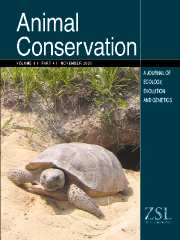Crossref Citations
This article has been cited by the following publications. This list is generated based on data provided by
Crossref.
Vitalis, Renaud
and
Couvet, Denis
2001.
Estimation of Effective Population Size and Migration Rate From One- and Two-Locus Identity Measures.
Genetics,
Vol. 157,
Issue. 2,
p.
911.
Vitalis, R.
and
Couvet, D.
2001.
estim 1.0: a computer program to infer population parameters from one‐ and two‐locus gene identity probabilities.
Molecular Ecology Notes,
Vol. 1,
Issue. 4,
p.
354.
Sarmiento, Esteban E.
2002.
Gorilla Biology.
p.
432.
Wang, Jinliang
and
Whitlock, Michael C
2003.
Estimating Effective Population Size and Migration Rates From Genetic Samples Over Space and Time.
Genetics,
Vol. 163,
Issue. 1,
p.
429.
BELLEMAIN, E.
and
TABERLET, P.
2004.
Improved noninvasive genotyping method: application to brown bear (Ursus arctos) faeces.
Molecular Ecology Notes,
Vol. 4,
Issue. 3,
p.
519.
Pertoldi, Cino
and
Topping, Chris
2004.
Impact Assessment Predicted by Means of Genetic Agent-Based Modeling.
Critical Reviews in Toxicology,
Vol. 34,
Issue. 6,
p.
487.
Morin, Phillip A.
Luikart, Gordon
Wayne, Robert K.
and
the SNP workshop group
2004.
SNPs in ecology, evolution and conservation.
Trends in Ecology & Evolution,
Vol. 19,
Issue. 4,
p.
208.
LEBERG, PAUL
DeYoung
and
Brennan
2005.
GENETIC APPROACHES FOR ESTIMATING THE EFFECTIVE SIZE OF POPULATIONS.
Journal of Wildlife Management,
Vol. 69,
Issue. 4,
p.
1385.
Theodorakis, Christopher W.
Lee, Kai-Lin
Adams, S. Marshall
and
Law, C. Brandon
2006.
Evidence of Altered Gene Flow, Mutation Rate, and Genetic Diversity in Redbreast Sunfish from a Pulp-Mill-Contaminated River.
Environmental Science & Technology,
Vol. 40,
Issue. 1,
p.
377.
LIPPÉ, CATHERINE
DUMONT, PIERRE
and
BERNATCHEZ, LOUIS
2006.
High genetic diversity and no inbreeding in the endangered copper redhorse,Moxostoma hubbsi(Catostomidae, Pisces): the positive sides of a long generation time.
Molecular Ecology,
Vol. 15,
Issue. 7,
p.
1769.
Hallerman, Eric M.
Grobler, Paul J.
and
Jones, Jess W.
2007.
Aquaculture Genome Technologies.
p.
109.
PALSTRA, FRISO P.
and
RUZZANTE, DANIEL E.
2008.
Genetic estimates of contemporary effective population size: what can they tell us about the importance of genetic stochasticity for wild population persistence?.
Molecular Ecology,
Vol. 17,
Issue. 15,
p.
3428.
Winterrowd, Michael F.
Dobson, F. Stephen
Hoogland, John L.
and
Foltz, David W.
2009.
Social Subdivision Influences Effective Population Size in the Colonial-Breeding Black-Tailed Prairie Dog.
Journal of Mammalogy,
Vol. 90,
Issue. 2,
p.
380.
Portnoy, David S.
McDowell, Jan R.
McCandless, Camilla T.
Musick, John A.
and
Graves, John E.
2009.
Effective size closely approximates the census size in the heavily exploited western Atlantic population of the sandbar shark, Carcharhinus plumbeus.
Conservation Genetics,
Vol. 10,
Issue. 6,
p.
1697.
Tende, Talatu
Ottosson, Ulf
Hansson, Bengt
Åkesson, Mikael
and
Bensch, Staffan
2010.
Population size of lions in Yankari Game Reserve as revealed by faecal DNA sampling.
African Journal of Ecology,
Vol. 48,
Issue. 4,
p.
949.
Luikart, Gordon
Ryman, Nils
Tallmon, David A.
Schwartz, Michael K.
and
Allendorf, Fred W.
2010.
Estimation of census and effective population sizes: the increasing usefulness of DNA-based approaches.
Conservation Genetics,
Vol. 11,
Issue. 2,
p.
355.
Berry, Oliver
and
Kirkwood, Roger
2010.
Measuring Recruitment in an Invasive Species to Determine Eradication Potential.
The Journal of Wildlife Management,
Vol. 74,
Issue. 8,
p.
1661.
Koelewijn, H. P.
Pérez-Haro, M.
Jansman, H. A. H.
Boerwinkel, M. C.
Bovenschen, J.
Lammertsma, D. R.
Niewold, F. J. J.
and
Kuiters, A. T.
2010.
The reintroduction of the Eurasian otter (Lutra lutra) into the Netherlands: hidden life revealed by noninvasive genetic monitoring.
Conservation Genetics,
Vol. 11,
Issue. 2,
p.
601.
Andersen, John J.
Portnoy, David S.
Hafner, John C.
and
Light, Jessica E.
2013.
Populations at risk: conservation genetics of kangaroo mice (Microdipodops) of the Great Basin Desert.
Ecology and Evolution,
Vol. 3,
Issue. 8,
p.
2497.
Capderrey, Cécile
Kaufmann, Bernard
Jean, Pauline
Malard, Florian
Konecny-Dupré, Lara
Lefébure, Tristan
Douady, Christophe J.
and
Pinto, João
2013.
Microsatellite Development and First Population Size Estimates for the Groundwater Isopod Proasellus walteri.
PLoS ONE,
Vol. 8,
Issue. 9,
p.
e76213.


